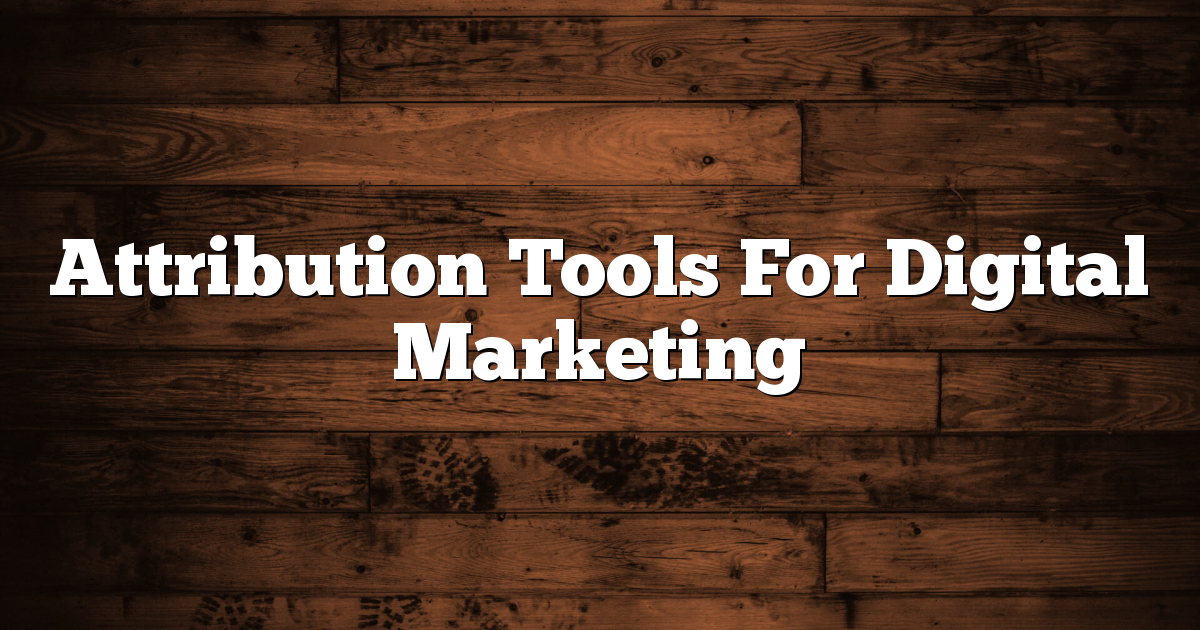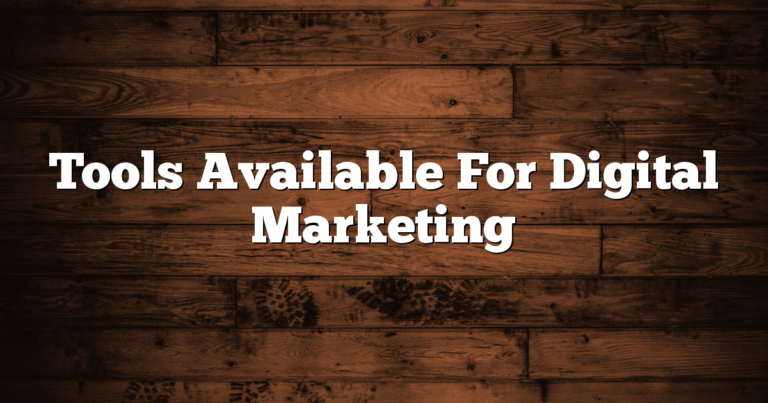Attribution Tools For Digital Marketing

Hey there, fellow digital enthusiasts! Are you tired of playing the guessing game when it comes to measuring the success of your marketing efforts? Well, fret no more because I've got some exciting news for you. Today, we're diving headfirst into the world of attribution tools for digital marketing. Now, I know what you're thinking, “What the heck are attribution tools?” Don't worry, my friend, I've got your back. In this article, we'll break down everything you need to know about these nifty tools that can revolutionize your marketing game. So, buckle up and get ready to uncover the secrets behind measuring the true impact of your digital campaigns. Let's dive in!
Importance of Attribution Tools in Digital Marketing
Alright, let's talk about the importance of attribution tools in digital marketing. Now, you might be wondering what the heck are attribution tools? Well, my friend, they are like the Sherlock Holmes of the digital marketing world. They help you figure out which marketing efforts are actually driving results and which ones are just wasting your time and money.
Picture this: you're running a digital marketing campaign and you've got ads all over the place – on social media, search engines, and even on websites. Now, without attribution tools, it's like shooting in the dark. You have no idea which ad is bringing in the most customers or which one is making people click away faster than a cheetah chasing its prey. But with attribution tools, you can track the entire customer journey from the first click to the final purchase. It's like having a GPS for your marketing efforts.
These tools not only help you understand which channels are driving the most conversions, but they also give you insights into the specific touchpoints that are influencing your customers along the way. You can see if it was that catchy Facebook ad that caught their attention or if it was that influencer's glowing review on Instagram. This information is pure gold, my friend. It allows you to optimize your marketing strategy and allocate your budget where it really matters. No more wasting money on ads that are as effective as a screen door on a submarine.
So, if you're serious about digital marketing, attribution tools are a must-have in your toolkit. They give you the power to make data-driven decisions and maximize your return on investment. With these tools by your side, you'll be able to navigate the complex world of digital marketing with confidence and finesse. So, go ahead and embrace the power of attribution tools, my friend. Your marketing efforts will thank you.
Types of Attribution Models for Digital Marketing
Alright, let's dive into the world of digital marketing and talk about attribution models. Now, when it comes to tracking the effectiveness of your marketing efforts, attribution models are like your trusty sidekick. They help you understand which channels and touchpoints are driving the most conversions and ultimately, where to allocate your precious marketing budget.
First up, we have the “First Touch” attribution model. This bad boy gives all the credit to the very first interaction a customer has with your brand. It's like love at first sight, you know? So, if someone stumbles upon your website through a Google search and then makes a purchase, the credit goes to that initial search. Simple, right? Well, it's great for understanding how you're attracting new customers, but it doesn't give much credit to the other touchpoints along the customer journey.
Next, we have the “Last Touch” attribution model. This one is all about giving credit where credit is due, but only to the last touchpoint before a conversion. It's like the grand finale of a fireworks show. So, if a customer sees your ad on Facebook, clicks on it, and then makes a purchase, Facebook gets all the glory. This model is straightforward and easy to understand, but it neglects the impact of other touchpoints that may have influenced the customer's decision.
Now, let's talk about the “Multi-Touch” attribution model. This one is like a team effort, where everyone gets a piece of the pie. It takes into account all the touchpoints a customer interacts with throughout their journey. It's like a puzzle, piecing together the different channels and touchpoints that led to a conversion. This model gives a more holistic view of your marketing efforts, but it can be a bit complex to analyze and assign credit accurately.
So, there you have it, my friend. These are just a few of the attribution models you can use in digital marketing. Each has its pros and cons, and it's up to you to choose the one that best suits your business goals and objectives. Just remember, attribution models are like a compass in the vast sea of digital marketing, guiding you towards success.
FirstTouch Attribution: Understanding the Initial Customer Interaction
Alright, let's dive into the fascinating world of first touch attribution and get a better understanding of that initial customer interaction. Picture this: you're browsing the internet, scrolling through social media, and suddenly you stumble upon an ad that catches your eye. You click on it, and boom! That's the first touch, the very first interaction between you and the brand. But what does it all mean?
First touch attribution is all about giving credit where credit is due. It's about recognizing the importance of that initial customer interaction and understanding its impact on the customer journey. You see, that first touch can be a game-changer. It's like the spark that ignites the fire of interest in a potential customer. It sets the stage for everything that follows.
Now, let's break it down even further. When we talk about first touch attribution, we're talking about tracking and analyzing the various touchpoints a customer has with a brand before making a purchase or taking any desired action. It's about understanding which marketing channels or campaigns played a role in capturing that customer's attention initially. Was it a social media ad, an email, a blog post, or maybe even a word-of-mouth recommendation? By identifying the first touchpoint, businesses can gain valuable insights into their marketing efforts and make informed decisions about where to allocate their resources.
In a nutshell, first touch attribution is like detective work for marketers. It helps them uncover the mysteries of customer behavior and figure out what really drives conversions. By understanding the initial customer interaction, businesses can optimize their marketing strategies, tailor their messaging, and ultimately create more meaningful connections with their target audience. So, the next time you come across an ad that piques your interest, remember that it's not just a random encounter. It's the first touch, the beginning of a potentially beautiful relationship between you and a brand.
LastTouch Attribution: Analyzing the Final Customer Touchpoint
So, let's talk about last touch attribution, my friend. This is all about analyzing that final customer touchpoint, the one that seals the deal and gets the cash flowing. You know, it's like when you're at a party and you're trying to impress someone. You can make a great first impression, but it's that last interaction that really determines whether you're going home alone or with a phone number.
Now, when it comes to last touch attribution, we're diving deep into the data to figure out which marketing channel or touchpoint gets all the credit for converting a customer. It's like playing detective, trying to find the smoking gun that leads to a sale. And let me tell you, it's not always as straightforward as it seems.
See, the thing is, customers these days are savvy. They're not just clicking on one ad and making a purchase. Oh no, they're browsing, researching, comparing prices, reading reviews, and doing all sorts of things before they finally hit that “buy now” button. So, when we're analyzing the final customer touchpoint, we need to take into account all the different interactions they've had along the way. We need to understand the customer journey, from that first click to the last touch, and everything in between. It's like putting together a puzzle, my friend, and every piece counts.
MultiTouch Attribution: Evaluating the Impact of Multiple Customer Interactions
MultiTouch Attribution: Understanding the True Impact of Every Customer Interaction
Alright, let's dive into the fascinating world of multi-touch attribution and how it helps us unravel the true impact of every customer interaction. You see, in today's digital age, customers interact with businesses through various touchpoints like websites, social media, emails, and ads. But here's the thing: attributing the success of a sale or conversion to just one touchpoint is like giving credit to a single actor in a blockbuster movie. It's simply not fair or accurate.
So, what is multi-touch attribution? Well, it's a method that allows us to assign value to each touchpoint along a customer's journey, giving us a more comprehensive understanding of how different interactions contribute to a desired outcome. It's like peeling back the layers of an onion to reveal the true essence of customer behavior.
Now, let's break down the process of multi-touch attribution. Imagine you're a customer looking to buy a new pair of sneakers. You start by searching for reviews online, then click on an ad that leads you to a brand's website. After browsing for a while, you receive an email with a limited-time discount, which prompts you to make the purchase. In this scenario, multi-touch attribution would help us identify the value of each touchpoint: the initial search, the ad click, and the email. By understanding the impact of each interaction, businesses can optimize their marketing strategies and allocate resources more effectively.
In conclusion, multi-touch attribution is like a detective's magnifying glass, allowing us to uncover the true impact of every customer interaction. It helps businesses make informed decisions, optimize their marketing efforts, and ultimately enhance the customer experience. So, the next time you're browsing online or receiving targeted ads, remember that behind the scenes, multi-touch attribution is working its magic to ensure you get the best possible experience.
Datadriven Attribution: Leveraging Analytics for Accurate Attribution
So, let's talk about data-driven attribution and how it can help us accurately attribute the success of our marketing efforts. You see, in the world of marketing, it's crucial to understand which channels and touchpoints are driving the most conversions and ultimately contributing to our bottom line. That's where data-driven attribution comes into play.
Data-driven attribution is all about leveraging analytics to determine the true impact of each marketing touchpoint on a customer's journey. It goes beyond the traditional last-click attribution model, which only gives credit to the last touchpoint before a conversion. With data-driven attribution, we can take into account all the touchpoints a customer interacts with throughout their journey and assign appropriate credit to each one based on its influence.
Now, you might be wondering how data-driven attribution actually works. Well, it starts by collecting and analyzing data from various sources such as website analytics, CRM systems, and marketing automation platforms. This data is then used to build a comprehensive view of the customer journey, mapping out all the touchpoints and interactions along the way.
Once we have this data, we can apply advanced statistical models and algorithms to determine the contribution of each touchpoint. These models take into account factors like the order and timing of touchpoints, the type of channel used, and the behavior of the customer. By analyzing all these variables, we can accurately attribute the success of our marketing efforts and make data-driven decisions on where to allocate our resources.
In conclusion, data-driven attribution is a powerful tool that allows us to accurately attribute the success of our marketing efforts. By leveraging analytics and advanced statistical models, we can gain a comprehensive understanding of the customer journey and assign appropriate credit to each touchpoint. This enables us to make data-driven decisions and optimize our marketing strategies for maximum impact. So, let's embrace data-driven attribution and unlock the true potential of our marketing efforts.
Challenges in Implementing Attribution Tools for Digital Marketing
So, let's talk about the challenges in implementing attribution tools for digital marketing. Now, attribution tools are like the Sherlock Holmes of the marketing world. They help you figure out which marketing efforts are actually driving results and which ones are just wasting your time and money. But, like any good detective, these tools have their fair share of challenges to overcome.
First off, one of the biggest challenges is the sheer complexity of the digital marketing landscape. With so many different channels and touchpoints, it can be a real headache trying to track and attribute conversions accurately. You've got social media ads, search engine marketing, email campaigns, influencer partnerships, and the list goes on. Each of these channels has its own unique tracking mechanisms and attribution models, making it difficult to get a holistic view of your marketing efforts.
Another challenge is the ever-changing nature of digital marketing platforms. Just when you think you've got a handle on how to track conversions on Facebook, they go and change their algorithm or update their ad platform. This constant evolution means that attribution tools need to be constantly updated and adapted to keep up with the latest changes. It's like trying to hit a moving target, and it can be frustrating to stay on top of all the updates and ensure that your attribution data is accurate and up to date.
Lastly, there's the issue of data privacy and compliance. With the increasing focus on data protection and privacy regulations, marketers need to be extra careful when it comes to collecting and using customer data. Attribution tools often rely on tracking pixels and cookies to gather data, which can raise concerns about privacy and compliance. Marketers need to navigate this minefield carefully, ensuring that they are collecting and using data in a way that is both legal and ethical.
So, as you can see, implementing attribution tools for digital marketing is no walk in the park. It requires navigating a complex landscape, keeping up with ever-changing platforms, and ensuring compliance with data privacy regulations. But, despite these challenges, attribution tools are still a valuable asset for any marketer looking to optimize their digital marketing efforts and get the most bang for their buck.
Best Practices for Using Attribution Tools in Digital Marketing Campaigns
Alright, let's dive into the world of attribution tools in digital marketing campaigns! These bad boys are like the secret sauce that helps you understand which marketing efforts are actually driving results. So, what are some best practices for using these tools effectively?
First things first, you gotta set clear goals and objectives for your campaign. Are you looking to increase brand awareness, drive website traffic, or boost sales? Knowing your endgame will help you choose the right attribution model and metrics to track. It's like picking the right tool for the job, ya know?
Next up, it's all about choosing the right attribution model. There are a few popular ones out there, like first-click, last-click, and multi-touch. Each model has its own strengths and weaknesses, so you gotta consider your specific campaign and audience. For example, if you're running a long-term campaign with multiple touchpoints, a multi-touch model might be the way to go. It's like finding the perfect pair of shoes that fit just right!
Once you've got your goals and attribution model sorted, it's time to track and analyze your data. Attribution tools can provide you with a wealth of information, from click-through rates to conversion rates. Take the time to dig into the data and identify patterns and trends. This will help you optimize your marketing efforts and make data-driven decisions. It's like being a detective, uncovering clues to crack the case of successful marketing!
So, there you have it, my friend! Best practices for using attribution tools in digital marketing campaigns. Set clear goals, choose the right attribution model, and analyze your data like a pro. With these tips in your back pocket, you'll be on your way to running killer campaigns that drive real results. Now go out there and conquer the digital marketing world!
Case Studies: Successful Implementation of Attribution Tools in Digital Marketing
Alright, let's dive into the world of digital marketing and talk about the successful implementation of attribution tools. Now, attribution tools are like the secret sauce of the digital marketing world. They help businesses understand which marketing channels are driving the most conversions and ultimately, the most bang for their buck. It's like having a crystal ball that reveals the true impact of your marketing efforts.
Picture this: you're a business owner and you've been investing your hard-earned cash into various marketing channels like social media ads, email campaigns, and good old-fashioned SEO. But here's the thing, you have no idea which channel is actually bringing in the customers. It's like throwing spaghetti at the wall and hoping something sticks. That's where attribution tools come in to save the day.
These tools work their magic by tracking and analyzing customer touchpoints across different marketing channels. They give you the power to see the entire customer journey, from the first click to the final purchase. With this information, you can make data-driven decisions and allocate your marketing budget where it matters most. It's like having a GPS for your marketing strategy, guiding you towards success.
Now, let's talk about some real-life examples of businesses that have successfully implemented attribution tools. Take Company X, for instance. They were struggling to figure out which marketing channels were driving the most conversions. They decided to implement an attribution tool and discovered that their social media ads were actually bringing in the majority of their customers. Armed with this knowledge, they were able to double down on their social media efforts and saw a significant increase in sales.
Another example is Company Y, a small e-commerce business. They were investing heavily in email marketing campaigns but weren't seeing the results they expected. By using an attribution tool, they realized that their email campaigns were indeed driving conversions, but it was the combination of email and social media ads that had the biggest impact. With this newfound insight, they adjusted their marketing strategy and saw a substantial boost in revenue.
So, there you have it. Attribution tools are the secret weapon in the digital marketing arsenal. They provide businesses with the insights they need to make informed decisions and maximize their marketing efforts. Whether you're a small business or a big player in the market, implementing attribution tools can be a game-changer. It's time to take control of your marketing strategy and unlock the true potential of your business.
Future Trends in Attribution Tools for Digital Marketing
Alright, let's dive into the future of attribution tools for digital marketing! Picture this: you're a savvy marketer, hustling to make your brand stand out in the digital jungle. You know that understanding the impact of your marketing efforts is crucial, but traditional methods of attribution just aren't cutting it anymore. That's where the future trends in attribution tools come in, my friend.
First up, we have the rise of multi-touch attribution. Gone are the days of giving all the credit to the last click before a conversion. With multi-touch attribution, you can track and analyze every touchpoint along the customer journey. From that first ad they saw on social media to the email that sealed the deal, you'll have a comprehensive view of how each interaction contributes to a conversion. It's like having a magnifying glass to zoom in on the specific moments that matter most.
Next, let's talk about the power of machine learning in attribution. As technology continues to advance, so does our ability to crunch massive amounts of data. Machine learning algorithms can now analyze patterns and trends in customer behavior, helping you identify the most effective marketing channels and tactics. It's like having a personal data scientist on your team, constantly learning and optimizing your marketing strategy for maximum impact. Talk about a game-changer!
Lastly, we can't ignore the growing importance of cross-device attribution. In today's mobile-first world, customers are constantly switching between devices. They might start browsing on their phone, switch to their laptop to make a purchase, and then check out reviews on their tablet. Cross-device attribution allows you to connect the dots and understand how each device contributes to the customer journey. It's like having a GPS tracker for your marketing efforts, guiding you through the twists and turns of the digital landscape.
So there you have it, my friend. The future of attribution tools for digital marketing is all about multi-touch attribution, machine learning, and cross-device tracking. These trends are revolutionizing the way we understand the impact of our marketing efforts. With these tools in your arsenal, you'll be able to navigate the digital jungle with confidence and make data-driven decisions that drive real results. Now go out there and conquer the world of digital marketing!
Another post you might find useful is, Adobe Tools For Digital Marketing.
I've also written about Best Digital Marketing Tools For Startups, so feel free to check that out, or bookmark it for later!






